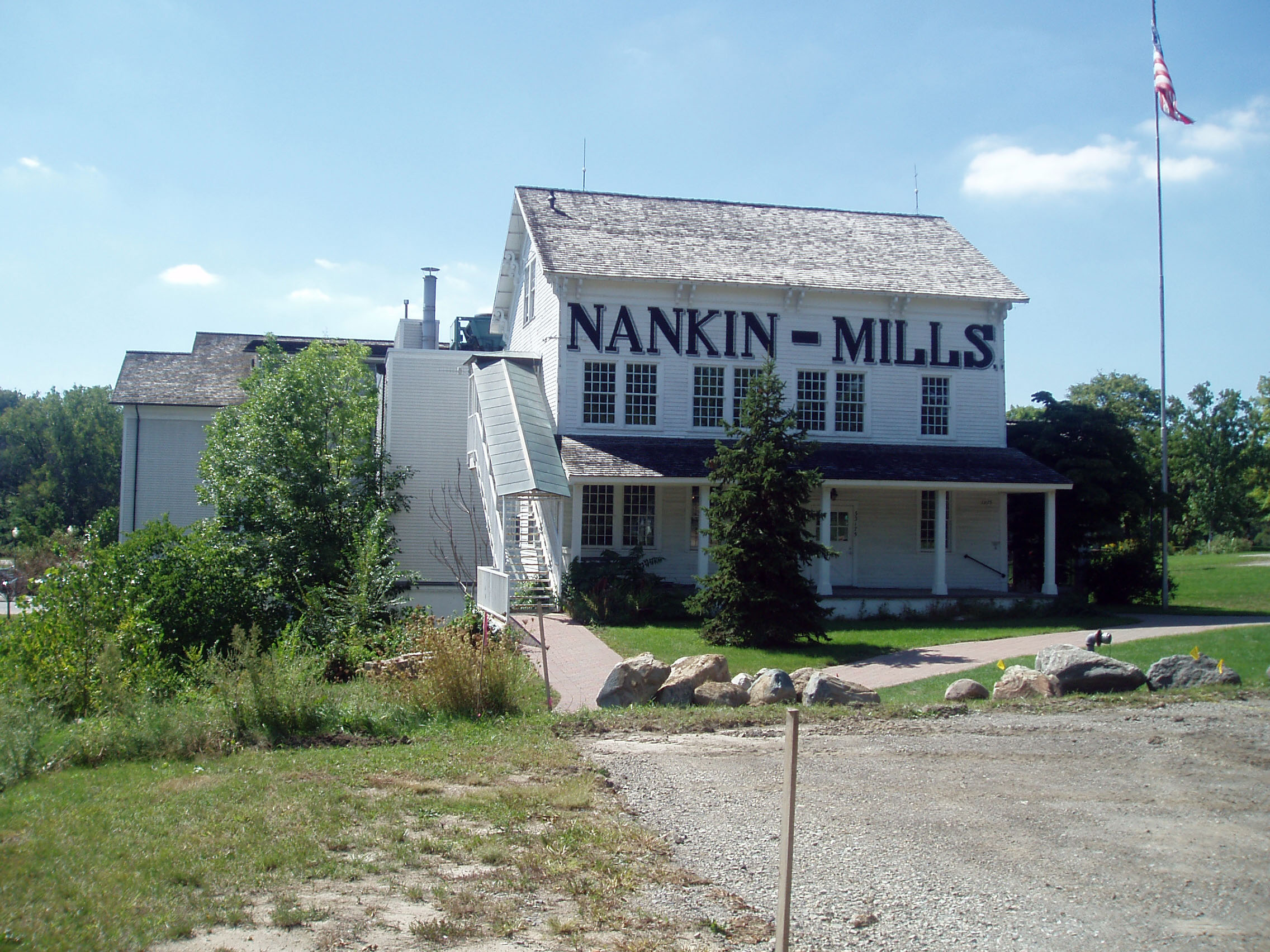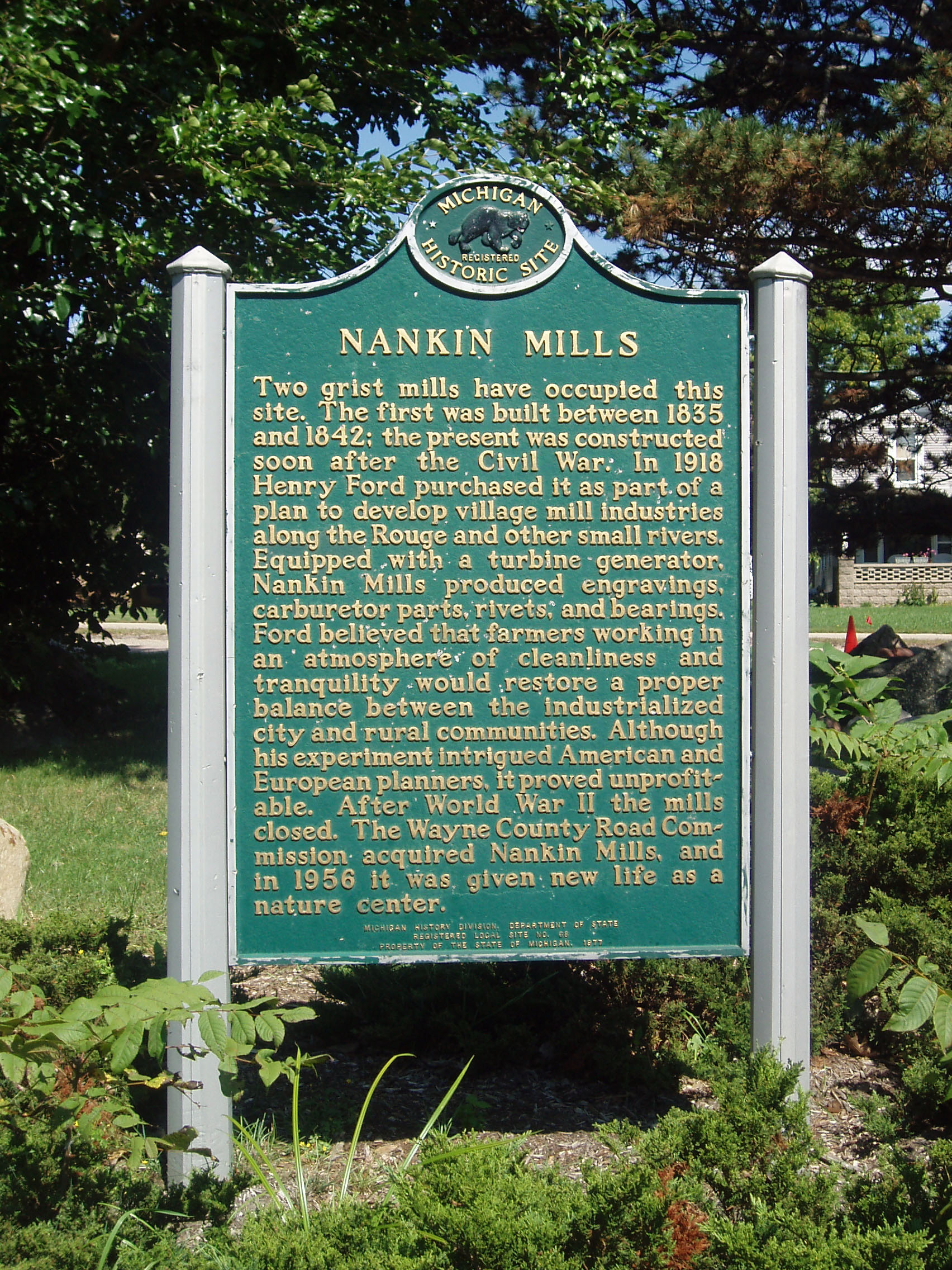
Nankin Mills
33175 Ann Arbor Trail, Westland, Michigan 48185
This is a State of Michigan historic site because it was the location of one of Henry Ford’s Village Industries. Just after World War I, when Henry Ford was building and expanding the world’s largest manufacturing complex at River Rouge, he also decided to experiment with village industries. These were to be small plants located in rural areas fairly close to Dearborn that would employ modest numbers of workers to make component parts for his vehicles. Henry Ford never wrote a long explanation for why he experimented with village industries. Furthermore, since he made all the key decisions for his firm, he did not have to present a management plan for village industries to a Board of Directors or gain the approval of federal agencies. Those who have written about the village industries speculate that Henry Ford knew that farmers’ incomes were low and that some of them could work in a nearby plant and still maintain their farms. This may have been his motivation. Henry Ford also had a consistent interest in what we now call alternative sources of energy. Many of his village industries were former mills that utilized water power. Ford stated his own belief that the United States would not become a nation of huge cities. He expected the growth of many moderate sized cities so this view may have encouraged him to experiment with village industries. By the time he started his village industries—about 1920—the Studebaker plant in Detroit had been unionized. Ford consistently opposed unions and this may have played a role in his decision to create small plants, but I have never seen any documentation of this.
Henry Ford established 19 village industries:
the first one—in
Northville—opened in 1920,
while the last one—in Cherry Hill—opened
in 1945. The one in Nankin Mills was the second one to open and was the closest
to Dearborn: just 12 miles away. The one in Brooklyn, Michigan was 60 miles
from Dearborn. Only two of the 19 small factories closed before the end of
World War II, but 16 of them were shuttered between 1947 and the late 1950s.
The one in Northville remained in operation until 1989. The maximum employment
in the factories ranged from a low of just 19 workers in the Sharon Mills
plant to about 1,500 in the Ypsilanti plant. Henry Ford was known for employing
many black workers in his Detroit and Dearborn plants, but apparently no
blacks were employed in any of his village industry plants until President
Roosevelt
Fair Employment Practices Employment went into operation in 1942.  Remarkably,
I believe that all of the plants used in Ford’s village industry program
are still standing in 2007. Most of them are in use, but for purposes other
than manufacturing. Extensive information about each of the village industry
plants is available in the appendix of Henry Ford’s Village Industries:
Recasting the Machine Age by Howard P. Segal (Boston: University of Massachusetts
Press, 2005)
Remarkably,
I believe that all of the plants used in Ford’s village industry program
are still standing in 2007. Most of them are in use, but for purposes other
than manufacturing. Extensive information about each of the village industry
plants is available in the appendix of Henry Ford’s Village Industries:
Recasting the Machine Age by Howard P. Segal (Boston: University of Massachusetts
Press, 2005)
The small village of Nankin Mills was established in the 1830s. As early as 1835, the first mill was built using water channeled from the Middle River Rouge. I do not know whether this mill actually operated, but by 1842, an active milling operation was located here. In 1863, Samuel Hardenbergh apparently razed the existing mill, rerouted the Middle River Rouge and built the structure that you see with its Greek Revival elements.
In the Nineteenth Century grains were milled locally to produce flour, but with the growth of the railroads, improvements in packaging, and the development of national firms, local millers found they could no longer compete. The large conglomerates drove the small millers out of business, just as a few large national brewers led local brewers to close in the 1960s and 1970s. It seems likely that Henry Ford visited the Nankin grist mills when he growing up on his family’s Dearborn farm. Indeed, he may have taken grain to this mill in his youth. Nankin Mills was still operating as a mill when Henry Ford bought the property in 1920 and converted it into his second village industry. Originally, the plant used a water turbine Ford installed, and employed 12 workers who produced screws. Henry Ford, in 1927, observed that its water power could be used to make something more than just screws, so he decided to move all his engraving operations from Dearborn to Nankin Mills. The plant was the only source for all the engravings used by the Ford industries. This included stencils, script dies and employee identification badges. In 1937, Ford modernized and expanded the plant. The maximum employment at the Nankin Mills factory was 70 in 1941.
After the death of Henry Ford in 1946, the management of Ford was drastically modernized and restructured. Most of the village industries were closed within a decade or so. This Nankin Mills plant was closed in 1948. Clara Ford, Henry Ford’s widow, gave this property to Wayne County in that same year. By that time, the county had completed constructed the Edward Hines Parkway which is a pleasant road with parkland on either side stretching about 17 miles from Northville to Dearborn Heights. Wayne County Division of Parks located their offices in Ford’s Nankin Mills building. In 2001, they opened an Interpretive Center focused on the history of the area. Nankin Mills has been affiliated with the National Park Service for the last couple of years. That federal agency designated it as a Gateway Hub for the Motor Cities National Historic Area. Thirty-seven National Historic Areas have been designed by Congress. They are affiliated with but not maintained or funded by the National Park Service.
The Middle Rouge River no longer flows through this plant. I believe that change occurred with the 1937 remodeling of the Nankin Mills building and the construction of the Edward Hines Parkway at about the same time. I do not know why the small village that was founded in the 1830s and is now inside the city of Westland was called Nankin Mills.
Date of construction: Construction of the first mill on this site began about 1835. This building may not have been completed, but another mill was erected here in about 1842. Samuel Hardenbergh in 1863 replaced the old mill with a new one which is the building that you see. Henry Ford bought the property in 1918 but the Ford Company substantially remodeled and modernized the building between 1935 and 1937.
Architects: Unknown to me.
Architectural Style: Greek Revival
State of Michigan Registry of Historic Sites: P 25,362, Listed March
11, 1967
State of Michigan Historical Marker: Put in place March 22, 1977. This
is clearly visible in front of the building.
Use in 2007: Office building for the Wayne County Department of Parks
Historical preservation group for this building: Friends of Nankin Mills
Website for this historic preservation group: www.nankinmills.org
Website for the Motor Cities National Historic Area: www.autoheritage.com
Book about Henry Ford’s village industries: Howard P. Segal, Henry
Ford’s
Village Industries: Recasting the Machine Age. (Boston: University of Massachusetts
Press, 2005)
Photograph: Ren Farley; September 13, 2007
Description prepared: September, 2007
Return to Industrial Buildings